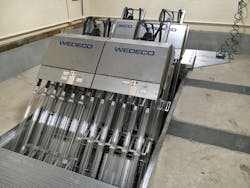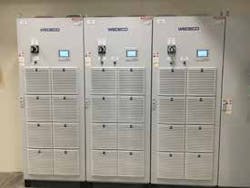Although St. Francis, Minnesota, located in Anoka and Isanti counties, has a population of only 7,218, it has big ideas when it comes to the future of its wastewater treatment system. Those big ideas came to fruition starting in 2015 when the city began building a new treatment facility at its existing wastewater treatment plant, which was built in the 1970s. Although upgraded in 2000, the upgrade did not address existing and future regulations regarding ammonia and phosphorus. The plant also needed to be expanded to provide additional capacity for the city’s growth. The $20 million project begun in 2015 was completed in 2018.
Innovation in the form of Ultra Violet disinfection
The new 0.814-MGD extended aeration plant includes aeration, detention, tertiary filtration, and both clear well pumping and wastewater reclamation facilities. The project also included a new lift station and elimination of the facility’s discharge outfall to the Rum River. In addition to the treatment plant, the city’s Department of Public Works is responsible for a sewer system consisting of about 19.5 miles of sewer main, 655 manholes, and nine lift stations.
The uncertainty of future regulatory limits caused the city to begin looking for ways to improve future sustainability along with greater potential to expand its capacity while creating a greener facility. The city and its consulting engineer, Bolton & Menk, recognized water reuse is a method by which they could accomplish these goals and provide a long term economic benefit to the community.
Filtration was already necessary due to effluent phosphorus requirements imposed to protect the Seelye Brooke and Rum River. Additional monitoring and disinfection capacity were all that were necessary to achieve the prescribed UV dose of 100 mJ/cm2 to achieve the five-log virus inactivation and the <2.2 total coliform counts on a seven-day geometric mean. The reuse water is immediately available for site irrigation at the wastewater treatment facility and the nearby public works facility. The city can pursue future expansion of reuse to community parks, golf courses, and ultimately residential lawns.
When selecting a UV system for non-potable reuse, St. Francis placed significant emphasis on ease of maintenance. Relying on the expertise of some city staff that had previous experience with horizontal UV systems that included ballasts in the modules, the city knew that UV system design features that reduced time consuming maintenance was critical. For this reason and several others, the city selected Xylem’s Wedeco Duron UV system. The Duron UV system, which is Title 22 accepted, is an inclined UV system that provides the easy maintenance the city required. At an inclined angle, the lamps are easy to reach and replace without havingto remove the equipment from the channel. The ballasts are in separate cabinets that make them easy to access for simple maintenance anytime. Finally, the Duron UV system is equipped with an automatic lifting system for ease of maintenance, off-season storage, and improved access to all related equipment.
The UV system features five UV banks in a single channel with two UV modules per bank and 12 lamps per module, for a total of 120 lamps. Arranging the system this way only required one ballast cabinet for every pair of UV banks.
Additional system features include:
- High efficiency Ecoray UV lamp and ballast technology
- OptiDose Control – true intensity based control philosophy using an ÖNORM-certified UV intensity sensor
- PLC controlled – an operator-friendly UV system control with SCADA communication
- Chemical-free, automatic, mechanical wiping system.
Operating ahead of the curve
With the help of Xylem and the low-maintenance Wedeco Duron UV system, St. Francis was able to make their goals of meeting new regulatory limits and efficiently expanding capacity a reality. Although sized to produce 2 MGD of wastewater for reuse, the new system is consistently operated at 0.3 MGD. The new plant is indeed a greener facility, as highly treated wastewater from the UV system is used for irrigation and other non-potable applications right on the premises.
Editor's Note: Scranton Gillette Communications and the SGC Water Group are not liable for the accuracy, efficacy and validity of the claims made in this piece. The views expressed in this content do not reflect the position of the editorial teams of Water & Wastes Digest, Water Quality Products and Storm Water Solutions.

